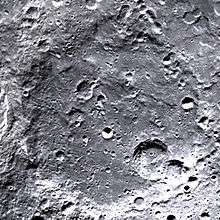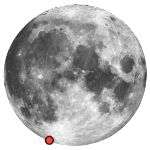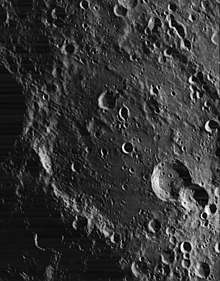Bailly (crater)
Bailly is a lunar impact crater that is located near the south-west limb of the Moon. It was named after French astronomer Jean S. Bailly.[1] The oblique viewing angle gives the crater a foreshortened appearance, and the location near the limb can limit visibility due to libration. The most favorable time for viewing this feature is near the full moon when the terminator is crossing the crater wall.
 Clementine image | |
| Coordinates | 66.8°S 69.4°W |
|---|---|
| Diameter | 303 km |
| Depth | 4.3 km |
| Colongitude | 65° at sunrise |
| Eponym | Jean S. Bailly |
Description


This is the largest crater on the near side of the Moon. In area it is comparable in size to a small mare. It lies north of the crater Le Gentil and east of Hausen. Further west of Bailly are the (unofficially named) Montes Dörfel mountains.
Bailly's uneven crater floor has remained free of lava flooding, and it is covered with a multitude of ridges and craters. The entire crater has been battered and worn, and the outer ramparts are eroded and in some places have even been worn away by myriad impacts. If the crater ever possessed a central peak, it is no longer discernible. Due to its current condition, observers have termed this feature a 'field of ruins'.
Bartolus
The south-eastern part of the crater is home to two notable craters, designated Bailly A and Bailly B. These craters overlap, and Bailly A lies across the rim of Bailly's mountainous wall. Selenographer Giovanni Battista Riccioli named Bailly B, Bartolus for fellow Ferrarese Jesuit Daniello Bartoli (1608-1685) in his Almagestum novum (1651). [2] The name was not recognized by the IAU.
Due to the size and the worn state of this crater, it is estimated to be more than 3 billion years old, and is part of the Nectarian system.[3]
.png)
Satellite craters
By convention these features are identified on lunar maps by placing the letter on the side of the crater midpoint that is closest to Bailly.
| Bailly | Coordinates | Diameter, km |
|---|---|---|
| A | 69.28°S 59.57°W | 43 |
| B | 68.74°S 63.25°W | 62 |
| C | 65.79°S 70.34°W | 19 |
| D | 65.25°S 72.38°W | 27 |
| E | 62.45°S 65.75°W | 16 |
| F | 67.46°S 69.59°W | 17 |
| G | 65.63°S 59.47°W | 19 |
| H | 63.57°S 62.59°W | 13 |
| K | 62.73°S 76.71°W | 19 |
| L | 60.71°S 71.13°W | 21 |
| M | 61.16°S 67.51°W | 20 |
| N | 60.53°S 63.68°W | 11 |
| O | 69.59°S 56.92°W | 19 |
| P | 59.57°S 60.67°W | 14 |
| R | 64.66°S 79.18°W | 17 |
| T | 66.49°S 73.83°W | 19 |
| U | 71.24°S 76.03°W | 24 |
| V | 71.91°S 81.45°W | 32 |
| Y | 61.04°S 65.60°W | 14 |
| Z | 60.22°S 65.86°W | 13 |
References
- "Bailly (crater)". Gazetteer of Planetary Nomenclature. USGS Astrogeology Research Program.
- Ewen A. Whitaker: Mapping and Naming the Moon, a history of lunar cartography and nomenclature, page 211.
- Stratigraphy of Lunar Craters, Don E. Wilhelms and Charles J. Byrne, 23 January 2009
- Andersson, L. E.; Whitaker, E. A. (1982). NASA Catalogue of Lunar Nomenclature. NASA RP-1097.CS1 maint: ref=harv (link)
- Bussey, B.; Spudis, P. (2004). The Clementine Atlas of the Moon. New York: Cambridge University Press. ISBN 978-0-521-81528-4.CS1 maint: ref=harv (link)
- Cocks, Elijah E.; Cocks, Josiah C. (1995). Who's Who on the Moon: A Biographical Dictionary of Lunar Nomenclature. Tudor Publishers. ISBN 978-0-936389-27-1.CS1 maint: ref=harv (link)
- McDowell, Jonathan (July 15, 2007). "Lunar Nomenclature". Jonathan's Space Report. Retrieved 2007-10-24.CS1 maint: ref=harv (link)
- Menzel, D. H.; Minnaert, M.; Levin, B.; Dollfus, A.; Bell, B. (1971). "Report on Lunar Nomenclature by the Working Group of Commission 17 of the IAU". Space Science Reviews. 12 (2): 136–186. Bibcode:1971SSRv...12..136M. doi:10.1007/BF00171763.CS1 maint: ref=harv (link)
- Moore, Patrick (2001). On the Moon. Sterling Publishing Co. ISBN 978-0-304-35469-6.CS1 maint: ref=harv (link)
- Price, Fred W. (1988). The Moon Observer's Handbook. Cambridge University Press. ISBN 978-0-521-33500-3.CS1 maint: ref=harv (link)
- Rükl, Antonín (1990). Atlas of the Moon. Kalmbach Books. ISBN 978-0-913135-17-4.CS1 maint: ref=harv (link)
- Webb, Rev. T. W. (1962). Celestial Objects for Common Telescopes (6th revised ed.). Dover. ISBN 978-0-486-20917-3.CS1 maint: ref=harv (link)
- Whitaker, Ewen A. (1999). Mapping and Naming the Moon. Cambridge University Press. ISBN 978-0-521-62248-6.CS1 maint: ref=harv (link)
- Wlasuk, Peter T. (2000). Observing the Moon. Springer. ISBN 978-1-85233-193-1.CS1 maint: ref=harv (link)
External links
- Wood, Chuck (2006-11-24). "A Little Basin". Lunar Photo of the Day. Archived from the original on 2007-04-01. Retrieved 2006-11-28.
| Wikimedia Commons has media related to Bailly (crater). |
